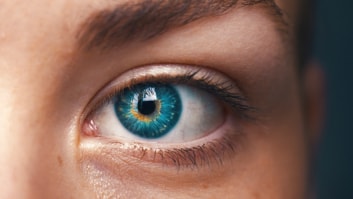AncestryDNA® Traits
Iris Patterns
Did you know that the patterns in your iris (the colored part of your eye) are a more accurate identifier than your fingerprints? If you look closely, you'll see different patterns, like rings and furrows, inside it. An AncestryDNA® + Traits test can tell you a little bit about what type of iris patterns you might have based on your DNA.
More About the Iris of Your Eye
Your eye has an iris that is an intricate web of tissue and muscle fibers. The iris controls the diameter of your pupil, which determines how much light reaches the retina.
This part of your eyeball, the iris, is a kaleidoscope of colors and patterns. The three most common iris patterns are pigmented rings, crypts, and furrows.
- Pigmented rings are wide, colored bands around the pupil that are a different shade than the rest of your iris.
- Crypts are tiny diamond-shaped holes in the iris that can range in size.
- Furrows are a series of pale lines that curve around the iris. They’re produced as the pupil opens (or dilates) and closes in response to light.

Genetics of Iris Patterns
Genes seem to play the only role in how your pupil and iris look. This makes them a phenotype, a visible DNA trait. More specifically, your genetics determine what type of iris patterns you have. About 2,000 genes are involved in the development of your iris, and around 50 affect your iris patterns.
Iris patterns are complicated, so it's hard to predict what kind of irises children will have based on their biological parents. For example, two parents with furrows won't necessarily have children whose irises have furrows.
A study found the overall likelihood of inheriting pigmented rings to be 93%, furrows 87%, and crypts 84%. But that doesn't explain why some family members may have these patterns, while others don't.
The Science Behind Iris Patterns
In the 1890s, Hungarian physician Ignatz Peczely invented iridology, the study of the iris. He thought iris patterns could be linked to specific diseases. But iridology isn't supported by any modern scientific studies.
Today, AncestryDNA looks at three genetic markers: the SLC24A4 gene on chromosome 12 (linked to pigmented rings); the SEMA3A gene on chromosome 7 (where AncestryDNA looks for crypt information); and the TRAF3IP1 gene on chromosome 2 (which appears to influence furrows). None of these markers guarantee that you will—or won’t—have a specific iris pattern, but they appear to increase or decrease your chances.
Fun Facts About the Iris of the Eye
Your iris patterns make it possible to use your eyes as a type of biometric identification that’s even more accurate than using your fingerprints—something used by iris recognition technology. This is because the patterns are very intricate and quite unique. Not even identical twins have iris patterns that are identical. And even the patterns of your right eye differ from those of your left eye.
Take a close look at your iris in the mirror. What do you see beyond your eye color? An AncestryDNA® + Traits test could tell you, based on your DNA, whether your iris might have furrows, crypts, and/or rings.
References
“Ask a Geneticist: Eye Color.” Stanford at The Tech Museum. September 23, 2010. https://genetics.thetech.org/ask/ask377.
Edwards, Melissa, et al. “Analysis of Iris Surface Features in Populations of Diverse Ancestry.” Royal Society Open Science 3, no. 1 (2016): 1–17. doi:10.1098/rsos.150424.
LaMotte, Sandee. “The Other ‘Fingerprints’ You Don't Know About.” CNN. December 4, 2015. https://www.cnn.com/2015/12/04/health/unique-body-parts.
Larsson, Mats et al. “GWAS Findings for Human Iris Patterns: Associations with Variants in Genes That Influence Normal Neuronal Pattern Development.” The American Journal of Human Genetics 89, no. 2 (2011): 334–43. doi:10.1016/j.ajhg.2011.07.011.
Larsson, Mats, Nancy L. Pedersen, and Håkan Stattin. “Importance of Genetic Effects for Characteristics of the Human Iris.” Twin Research: The Official Journal of the International Society of Twin Studies 6, no. 03 (2003): 192–200. doi:10.1375/twin.6.3.192.
Li, Stan Z., and Anil K. Jain. Encyclopedia of Biometrics. I-Z ed. Vol. 1. New York: Springer, 2009.
Quillen, Ellen E., et al. “Iris Texture Traits Show Associations with Iris Color and Genomic Ancestry.” American Journal of Human Biology 23, no. 4 (2011): 567–69. doi:10.1002/ajhb.21183.